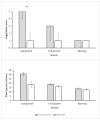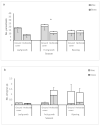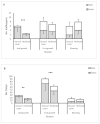Effect of Weed Management on the Parasitoid Community in Mediterranean Vineyards
- PMID: 33374201
- PMCID: PMC7823956
- DOI: 10.3390/biology10010007
Effect of Weed Management on the Parasitoid Community in Mediterranean Vineyards
Abstract
Enriching agroecosystems with non-crop vegetation is a popular strategy for conservation biocontrol. In vineyards, the effects of specific seeded or planted cover crops on natural enemies are well-studied, whereas conserving spontaneously developing weeds received less attention. We compared parasitoid communities between matched pairs of vineyard plots in northern Israel, differing in weed management practices: "herbicide", repeated herbicide applications vs. "ground cover", maintaining resident weeds and trimming them when needed. Using suction sampling, we assessed the parasitoids' abundance, richness, and composition during three grape-growing seasons. Ground cover plots had greater parasitoid abundances and cumulative species richness than herbicide-treated plots, possibly because of their higher vegetation cover and richness. Dominant parasitoid species varied in their magnitude and direction of response to weed management. Their responses seem to combine tracking of host distributions with attraction to additional vegetation-provided resources. Parasitoid community composition was mildly yet significantly influenced by weed management, while season, year, and habitat (weeds vs. vine) had stronger effects. Vineyard weeds thus support local biocontrol agents and provide additional previously demonstrated benefits (e.g., soil conservation, lower agrochemical exposure) but might also attract some crop pests. When the benefits outweigh this risk, weed conservation seems a promising step towards more sustainable agricultural management.
Keywords: community composition; conservation biological control; natural enemies; non-crop vegetation; parasitoids; vineyards; weed management.
Conflict of interest statement
The authors declare no conflict of interest. The funders had no role in the design of the study; in the collection, analyses, or interpretation of data; in the writing of the manuscript, or in the decision to publish the results.
Figures






References
-
- Barbosa P.A. Conservation Biological Control. Academic Press; San Diego, CA, USA: 1998.
-
- Begg G.S., Cook S.M., Dye R., Ferrante M., Franck P., Lavigne C., Lövei G.L., Mansion-Vaquie A., Pell J.K., Petit S. A functional overview of conservation biological control. Crop Prot. 2017;97:145–158. doi: 10.1016/j.cropro.2016.11.008. - DOI
-
- Mansion-Vaquié A., Ferrante M., Cook S., Pell J., Lövei G.L. Manipulating field margins to increase predation intensity in fields of winter wheat (Triticum aestivum) J. Appl. Entomol. 2017;141:600–611. doi: 10.1111/jen.12385. - DOI
-
- Fiedler A.K., Landis D.A., Wratten S.D. Maximizing ecosystem services from conservation biological control: The role of habitat management. Biol. Cont. 2008;45:254–271. doi: 10.1016/j.biocontrol.2007.12.009. - DOI
-
- Hassan K., Pervin M., Mondal F., Mala M. Habitat management: A key option to enhance natural enemies of crop pest. Univ. J. Plant. Sci. 2016;4:50–57. doi: 10.13189/ujps.2016.040402. - DOI
Grants and funding
LinkOut - more resources
Full Text Sources

